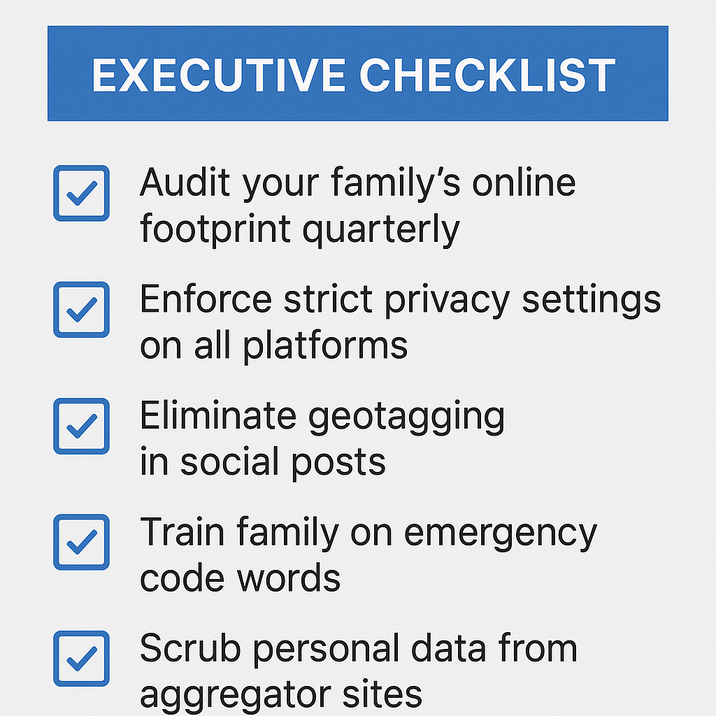Let’s imagine for a moment one of your board members getting a message that looks like it came from your child, panicked, and asking for help. Later that same day, an investor comes across a fake profile using your photos to promote a scam. None of it is real, but the fear and damage are. This is digital kidnapping, and executives, high-net-worth individuals, and high-profile persons are among its most attractive targets.
Executives, high-net-worth individuals, and public figures take note: criminals can exploit your family’s digital presence, and unless you take proactive steps, your wealth, reputation, and peace of mind could all be at risk.
Jump To:
ToggleTL;DR / Key Takeaways
- Digital kidnapping; the theft/misuse of photos, voices, or identities for scams, impersonation, or ransom hoaxes.
- Executives and HNW families are prime targets due to visibility, wealth, and online presence.
- Core risks: privacy erosion, financial fraud, family safety concerns, and reputational harm.
Defenses: control social visibility, train family protocols, engage executive privacy services, use AI monitoring, and prepare a crisis playbook.
A proactive plan shields both family and reputation.
Introduction
Today, with advances in cybercrime methods, namely AI, criminals don’t need to hack your accounts to impact you. Instead, they can simply steal your identity from the open web, your LinkedIn headshot, your voice on a podcast, a video of you on YouTube, your spouse’s Instagram posts, or your child’s school photo. Keep in mind, armed with these, they can very easily turn them into powerful tools of manipulation.
The practice known as digital kidnapping is a type of manipulation where the personal likenesses, voices, videos, and images of a person are essentially hijacked for fraud, extortion, or impersonation. Consequently, for executives and high-net-worth families, this can be a direct threat to wealth, reputation, and personal safety.
Why does it matter? Because one fake emergency call, one impersonated account, or one deepfake can ripple through your boardroom, investors, and family life in ways that can cost millions.
In this article, you will learn:
- What digital kidnapping is and how it works.
- Why executives and their families are prime targets.
- The key risks to privacy, finances, reputation, and safety.
- And what defenses and crisis strategies you, as an executive and HNWI, can do to stay protected.
So let’s get to it!
What is Digital Kidnapping?
Digital kidnapping is the unauthorized theft and reuse of personal images, voices, or identities, usually scraped directly from social media, professional platforms, or leaked databases. In contrast to ransomware, there’s no malware involved; your online presence is what’s going to be used for the attack.
Common Forms of Digital Kidnapping
- Photo Theft & Reposting: Criminals will search popular platforms like Instagram and Facebook to scrape family photos. They can then republish those photos under fake identities.
- Impersonation Accounts: Fraudsters can create fake LinkedIn or Instagram profiles using executive or HNWI headshots. With this, they can then solicit money or data.
- AI-Powered Voice Cloning: Advancements in AI make it easy to clone someone’s voice, and it takes only a few seconds to stage a ransom call that sounds indistinguishable from your child or spouse.
- Deepfake Manipulation: AI can also be used to take stolen photos and turn them into convincing videos. There have been numerous instances where these deepfake videos have been used to damage careers or spread disinformation.
Real-World Example
In 2023, U.S. families reported receiving calls where a cloned voice of their child begged for help, followed by a ransom demand. As a result, the Federal Trade Commission confirmed a surge in these AI-powered “virtual kidnappings,” advising families to use code words to verify real emergencies. More on coded words later.

How Digital Kidnapping Threatens Your Family and Reputation
Digital kidnapping creates four critical risks for executives and HNW families.
1. Loss of Personal Privacy
When family photos or executive headshots are public, they can be copied, misused, and repurposed for scams or impersonations.
Case: In 2015, Time Magazine reported on parents discovering that photos of their children posted on Instagram had been stolen by strangers who re-posted them under fake accounts, pretending the children were theirs.
Takeaway: Every photo you or your family share online is more than a memory, unfortunately it’s also a piece of data criminals can weaponize against you.
2. Financial Extortion and Fraud
AI voice clones and fake emergencies are now so convincing that they can trick even the most cautious executives into paying ransoms or making money transfers.
Case: One executive nearly wired $50,000 after hearing what sounded like his daughter crying for help in a cloned voice call.
Takeaway: Wealth makes you a prime target, and panic can lead to costly mistakes.
3. Family Safety Risks
When you share excessive details on social media like schools, vacations, or daily routines. This can expose your loved ones to unwanted contact and risk.
Case: In 2023 in Arizona, a mother received a terrifying call where she heard what she believed was her 15-year-old daughter crying for help. Criminals had used an AI-cloned voice that they took from her daughter’s social media posts to stage a fake kidnapping and demand ransom.
Takeaway: What seems like harmless sharing online can create real-world dangers.
4. Reputation and Trust Damage
Fake profiles and deepfakes can undermine your credibility with boards, investors, and the media.
Case: In Hong Kong, a finance worker sent millions to impostors in a deepfake video conference that imitated executives he worked with.
Takeaway: Trust is fragile, one fake narrative can erode years of hard-won credibility.

Proven Strategies to Stay Ahead of Digital Kidnapping
So what can executives and HNWIs do to defend their personal and family identities? One thing is certain: it requires the same discipline that’s applied in corporate security.
1. Control the Narrative: Manage Social Visibility
Firstly, you don’t need to post everything, executives, and their families must reduce the amount of exploitable information they post online.
Solutions:
- Set all family social accounts to private.
- Disable photo downloads and restrict friend/follower access.
- Turn off geotagging on smartphones and apps.
- Review LinkedIn every quarter to spot and report fake profiles pretending to be you.
Takeaway: Less visibility means fewer attack surfaces.
2. Establish Family Security Protocols
Families should operate with the same security discipline as a corporate team.
Solutions:
- Create a code word that every family member knows, and use it when faced with an emergency situation.
- Practice “pause and verify” drills so children and spouses don’t respond under pressure.
- Maintain a secondary communication channel (e.g., an encrypted app or backup phone).
Takeaway: By following outlined procedures, it prevents panic-driven mistakes.
3. Invest in Executive Privacy Services
Executives should treat personal data the way companies treat trade secrets. If it becomes too difficult to handle on your own, seek the assistance of professionals.
Solutions:
- Hire services like DeleteMe or OneRep to continuously remove personal details from people-search databases.
- Work with specialized privacy firms that scan for fake accounts in your name and can quickly remove them before they cause damage.
- Ensure household staff and assistants follow the same privacy practices.
Takeaway: Removing public data cuts attackers off at the source.
3. Use AI and Smart Monitoring Tools
Just as cybercriminals can use AI against you, AI can also work for you.
Solutions:
- Set up Google Alerts for your name, company, and family.
- Run regular reverse image searches to spot stolen photos.
- Use AI-powered monitoring services that scan the web for deepfakes, cloned voices, or impersonation accounts and alert you instantly.
Takeaway: The right tools, which include AI, act as an early warning system, giving you time to detect problems and respond before they escalate.
4. Prepare a Crisis Playbook
When an attack occurs, time is your most valuable asset.
Solutions:
- Have trusted legal, PR, and cybersecurity experts lined up in advance so they can act fast if fake profiles or scams appear.
- Draft internal communication protocols so your board and staff know how to validate requests.
- Keep a step-by-step response checklist accessible to family and assistants.
Takeaway: Speed of response defines the outcome.

Top 10 Defenses for Executives (Checklist)
- Audit your family’s online footprint quarterly.
- Enforce strict privacy settings on all platforms.
- Eliminate geotagging in social posts.
- Train family on emergency code words.
- Scrub personal data from aggregator sites.
- Set monitoring alerts for names and brands.
- Watermark sensitive or professional photos.
- Adopt AI tools to detect deepfake misuse.
- Draft a rapid response plan for crises.
- Engage an executive privacy firm for ongoing oversight.
The Bigger Picture. Beyond Digital Kidnapping
Digital kidnapping is just the starting point; executives face a much bigger range of online risks. Here are a few:
- Digital Fingerprinting & Open Source Intelligence (OSINT): Attackers use public records and posts to build detailed profiles. Studies show 65% of executives have enough exposed data for identity theft.
- AI-Powered Surveillance: By 2026, Gartner predicts the frightening possibility that over 30% of leaders will be impersonated in deepfake fraud attempts.
- IoT & Location Risks: Smart home devices, fitness apps, and connected cars leak data that criminals exploit.
Why it matters: Executives’ voices, images, and lifestyles are often public, which makes them easy targets. Digital kidnapping is only a part of larger threats.
Conclusion + Quick Recap
Digital kidnapping is real and on the rise, with executives and HNWIs being prime targets. As mentioned before, criminals don’t need to break into your systems or your phone; they can attack you from what you and your family share online.
Quick Recap
- Digital kidnapping = theft/misuse of identity, images, or voices.
- Risks: privacy, financial loss, family safety, and reputation.
- Solutions: social media controls, family protocols, privacy services, AI monitoring, and crisis playbooks.
- Big picture: AI, OSINT, and IoT are amplifying exposure.
FAQs on Digital Kidnapping
1. Is digital kidnapping illegal?
Yes—identity theft, impersonation, and extortion are all prosecutable, though jurisdiction complicates enforcement.
2. Can you fully prevent it?
No, it may be difficult, but you can reduce risk dramatically with privacy controls, monitoring, and protocols.
3. Who is most at risk?
Executives, HNW families, and public figures. Criminals often target children first because parents are more likely to react quickly when they think their child is in danger.
4. What tools work best?
Privacy scrubbing services, AI monitoring platforms, and executive-level crisis teams.
5. How should you respond if targeted?
Stay calm, check with your family code word, save proof, report it right away, and call your legal and PR teams to respond.
6. Why is this bigger for executives?
Because damage to your reputation or finances can quickly spread—shaking the confidence of your board, investors, and even the market.







